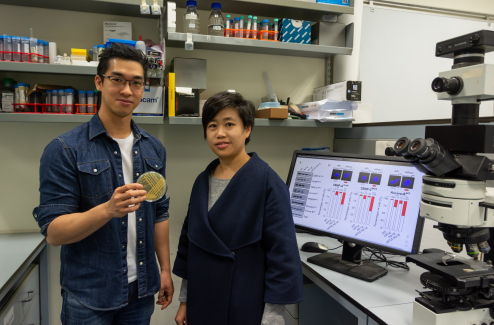Research Stories
VP(R)'s Picks: New Discovery on Cell Division
Back
Errors in cell division can mean cells end up with an abnormal number of chromosomes, leading to disease and other health problems. Research from the School of Biological Sciences explains how these errors may arise, opening a new avenue for exploring diagnostic biomarkers and potential therapies.
To ensure the genetic code (or DNA) in our cells is maintained accurately, each cell must replicate precisely in each cell cycle and distribute its chromosomes equally between the two daughter cells. If this doesn’t happen, cells may end up with an abnormal number of chromosomes, resulting in spontaneous abortion, genetic diseases or cancers. New research by Associate Professor Dr Karen Wing Yee Yuen and Postdoctoral Fellow Dr Yick Hin Ling explains how this may happen.
The element on each chromosome that is important for chromosome movement during cell division is the centromere. The researchers discovered that centromeric DNA produces centromeric RNA (cenRNA), which keeps chromosomes stable. If there is too much or too little cenRNA, the centromere itself will become defective and chromosomes will be lost.
The finding supports the idea that certain RNA plays a vital role in cellular function and viability. Only 27% of RNA is involved in “coding”, in which the DNA code is copied into the RNA molecule where it becomes a recipe for the cell to make that protein. Non-coding RNA was long considered “junk” but recent findings, such as those of Dr Yuen and Dr Ling, have revealed its function in gene regulation and maintaining chromosome stability.
The findings were well-received and recommended by F1000Prime, whose members select the top 2% or so of all published articles in the biology and medical sciences each year.
Dr Yuen and Dr Ling will now try to determine if cenRNA could be used as a cancer biomarker because other recent research has shown ovarian and other cancers have abnormally high cenRNA expression.

The centromere is a key chromosomal element to ensure equal chromosome segregation. We introduced a small circular chromosome to the budding yeast cell to monitor its chromosome missegregation with different levels of cenRNAs. In this colour assay, any loss or missegregation of the circular chromosome during cell division will turn the daughter cells from red to white colour, forming a red-white sectoring colony.
Related paper: Ling Y.H. and Yuen K.W.Y., “Point centromere activity requires an optimal level of centromeric noncoding RNA”, Proceedings of the National Academy of Sciences of the USA, 2019, 116 (13) 6270-6279.




